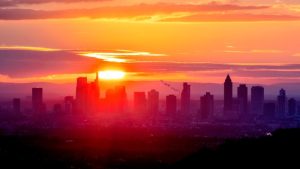five Venice Biennale shows across the city to catch now
Unlock the Editor’s Digest for free
Roula Khalaf, Editor of the FT, selects her favourite stories in this weekly newsletter.
This article is part of a guide to Venice from FT Globetrotter
The contemporary-art juggernaut that is the Venice Art Biennale draws to a close on November 24. With 30 pavilions at the Giardini and 25 at the Arsenale, there is plenty of art to see in the Biennale’s two main locations. Yet beyond the two principal sites are a multitude of national pavilions and sidebar events scattered all over the city, many of them in places otherwise inaccessible to the public. The following selection of exhibitions slices through the city from south to north, carving a straight(ish) path that takes you to some exceptional spaces. You could do them all in a day or simply dip into the list and pick what takes your fancy. Catch them now while you can.
‘With My Eyes’, The Holy See Pavilion

This groundbreaking collective exhibition is being held in the women’s prison on the Giudecca. The project is dedicated to the theme of human rights and people living on the margins of society. Brazilian artist Sonia Gomes fills the space of the ex-convent’s church with an installation of fabric pieces that dangle from the ceiling. Filmmaker Marco Perego’s Dovecote stars his wife Zoe Saldaña as a detainee. French artist Claire Tabouret has depicted the prisoners as children and young women, while ex-enfant terrible Maurizio Cattelan has painted a pair of feet on the prison façade. Many of the detainees contributed to the works’ making and act as guides to the exhibition. A physical and figurative breaking down of barriers occurs: the solitary becomes collective, prejudices and conventions are questioned, and worlds that rarely meet come together in this remarkable initiative. Due to its location, booking is essential, ID is required and under-18s are not permitted entry. Casa di Reclusione Femminile di Venezia-Giudecca, 713 Fondamenta delle Convertite, 30133 Venice. Open Thursday–Tuesday, 10am–6pm. Website; Directions
‘Nigeria Imaginary’, Nigeria Pavilion

Veering a little off course takes you to Palazzo Canal to the south of Campo Santa Margherita, which has become the temporary home of the Nigeria Pavilion. Spread over three floors, the Nigeria Imaginary exhibition includes works that focus on topics such as the country’s colonial past and its enduring relationship with the UK, as well as a look at Nigeria’s possible futures. British-born Onyeka Igwe’s installation “No archive can restore this chorus of (diasporic) shame” is an immersive aural and visual look at some of these themes. Ndidi Dike’s “Blackhood: A Living Archive” is both a memorial to Black lives lost and a rallying call to Black people on the African continent in the wake of the Black Lives Matter movement. The ground floor contains a model of the new Museum of West African Art in Benin, where this exhibition will soon be heading. Palazzo Canal, 3121 Rio Terà Canal, Dorsoduro, 30123 Venice. Open Wednesday–Sunday, 10am–6pm. Website; Directions
‘The Neighbours’, Bulgaria Pavilion


On the Zattere is the Don Orione Artigianelli Cultural Centre. Walking through its green and pleasant cloisters leads to the Bulgaria Pavilion’s dark and unsettling “The Neighbours”. The installation brings together artist and researcher Krasimira Butseva, history professor and documentary filmmaker Lilia Topuzova and multimedia artist and researcher Julian Chehirian. The trio have created a work that examines Bulgaria’s state violence between 1945 and 1989. Walking around the installation, made to look like three domestic environments, visitors hear the disembodied voices of survivors from the country’s labour camps and prisons testify to their experiences. A combination of meticulous academic research and artistic imagination, the work is harrowing but at the same time gives voice to the victims and bears witness to an all-but-forgotten past. Centro Culturale Don Orione Artigianelli, 919 Fondamenta Zattere, Dorsoduro, 30123 Venice. Open Wednesday–Sunday, 10am–6pm. Website; Directions
‘Selva’, Museo Fortuny


Crossing the Accademia Bridge from Dorsoduro leads to one of Venice’s hidden treasures: the Museo Fortuny. Once home to Spanish designer, photographer, painter and all-round Renaissance man Mariano Fortuny, the imposing palazzo is now a public museum. The museum itself is a joy and the admission price includes entry to Eva Jospin’s Selva exhibition. The French artist has used everyday materials such as cardboard, pieces of metal and textiles to meticulously craft strange and magical landscapes. Panelled passageways, arches encrusted with stalactites and walls of dense woods are all made of cardboard. Darkened rooms house embroidered paintings that evoke images from children’s fairy tales but also speak to the ecological issues of the present. San Marco 3958, 30124 Venice. Open Wednesday–Monday, 10am–6pm until October 31; 10am–5pm from November 1 to March 31 2025 (ticket office shuts one hour before closing time). Website; Directions
‘By the Means at Hand’, Croatia Pavilion


The final leg of this art-athon leads to the Croatia Pavilion in northern Cannaregio. Vlatka Horvat’s By the Means At Hand deftly tackles the Biennale’s “Foreigners Everywhere” theme head on. Housed in an old carpentry workshop, which doubles as exhibition space and the London-based artist’s home during her residency, the exhibition comprises works by artists living as foreigners all over the world — Horvat invited them to send her a custom-made piece to Venice. But she added a caveat: it could not arrive by courier or delivery service. The works are thus in situ thanks to an extensive network of relationships and an inherent trust in the kindness of others. The result is an outstanding assemblage by a collective bound together by a brilliant idea and their willingness to participate. In return, Horvat reciprocates by sending a collage to each artist that reflects on migration and displacement, but also on the support networks we rely on when living far from home. It is a dynamic, constantly changing exhibition with a sense of connectedness that is a cause for optimism in our fragmented times. Fàbrica 33, Calle Larga dei Boteri 5062, Cannaregio, 30121 Venice. Open Tuesday–Sun, 10am–6pm. Website; Directions
Share your Venice Biennale highlights — off-site and on-site — in the comments below. And follow FT Globetrotter on Instagram at @FTGlobetrotter
Cities with the FT

FT Globetrotter, our insider guides to some of the world’s greatest cities, offers expert advice on eating and drinking, exercise, art and culture — and much more
Find us in Venice, Paris, Rome, London, Tokyo, New York, Frankfurt, Singapore, Hong Kong, Miami, Toronto, Madrid, Melbourne, Copenhagen, Zürich, Milan, Vancouver and Edinburgh
#Venice #Biennale #shows #city #catch





